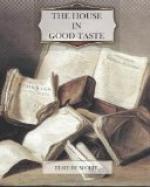There are now, fortunately, few communities in America that have not electric power-plants. Indeed, I know of many obscure little towns of a thousand inhabitants that have had the luxury of electric lights for years, and have as yet no gas or water-works! Miraculously, also, the smaller the town the cheaper is the cost of electricity. This is not a cut-and-dried statement, but an observation from personal experience. The little town’s electricity is usually a byproduct of some manufacturing plant, and current is often sold at so much per light per month, instead of being measured by meter. It is pleasant to think that many homes have bridged the smelly gap between candles and electricity in this magic fashion.
Gas light is more difficult to manage than electricity, for there is always the cumbersome tube and the necessity for adding mechanical accessories before a good clear light is secured. Gas lamps are hideous, for some obscure reason, whereas there are hundreds of simple and excellent wall fixtures, drop lights and reading lamps to be bought already equipped for electricity. The electric wire is such an unobtrusive thing that it can be carried through a small hole in any good vase, or jar, and with a suitable shade you have an attractive and serviceable reading light. Candlesticks are easily equipped for electricity and are the most graceful of all fixtures for dressing-tables, bedside tables, tea tables, and such.
It is well to remember that if a room is decorated in dark colors the light will be more readily absorbed than in a light-colored room, and you should select and place your lighting-fixtures accordingly. Bead covers, fringes and silk shades all obscure the light and re-absorb it, and so require a great force of light to illuminate properly.
The subject of the selection of lighting-fixtures is limitless. There are so many fixtures to be had nowadays—good, bad and indifferent—that it were impossible to point out the merits and demerits of them all. There are copies of all the best lamps and lanterns of old Europe and many new designs that grew out of modern American needs. There are Louis XVI lanterns simple enough to fit well into many an American hallway, that offer excellent lessons in the simplicity of the master decorators of old times. Contrast one of these fine old lanterns with the mass of colored glass and beads and crude lines and curves of many modern hall lanterns. I like a ceiling bowl of crystal or alabaster with lights inside, for halls, but the expense of such a bowl is great. However, I recently saw a reproduction of an old alabaster bowl made of soft, cloudy glass, not of alabaster, which sold at a fraction of the price of the original, and it seemed to meet all the requirements.
Of course, one may easily spend as much money on lighting-fixtures as on the remainder of the house, but that is no reason why people who must practise economy should admit ugly fixtures into their homes. There are always good and bad fixtures offered at the lowest and highest prices. You have no defense if you build your own house. If you are making the best of a rented house or an apartment, that is different. But good taste is sufficient armor against the snare of gaudy beads and cheap glass.




